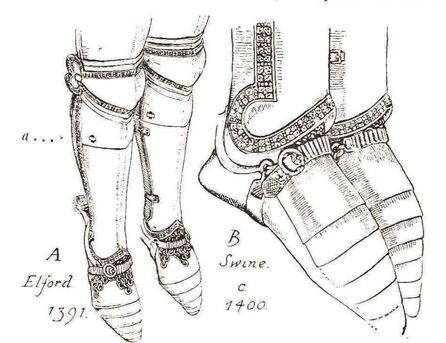
Is there a clue in the toecap?
The survey of the Lovel slab has revealed the left foot with greater clarity and shows it to be wearing a form of armoured shoe called a sabbaton which consists of a series of separate curved plates fixed at their ends to allow the foot to flex whilst walking or riding. An enhanced image from the survey shows that it has a semi-circular toe pointing to the right of the picture.
The survey of the Lovel slab has revealed the left foot with greater clarity and shows it to be wearing a form of armoured shoe called a sabbaton which consists of a series of separate curved plates fixed at their ends to allow the foot to flex whilst walking or riding. An enhanced image from the survey shows that it has a semi-circular toe pointing to the right of the picture.

Sabbatons were subject to fashion like any other form of foot-wear and the shape of the toe underwent extensive changes in Medieval times enabling them to be assigned to particular periods. Sabbatons with pointed toes were popular for much of the fourteenth and fifteenth centuries.
Illustration from Francis M. Kelly and Randolph Schawbe, A Short History of Costume and Armour, Vol. II, 1485-1800.
Kelly and Schawbe describe the changing toe styles on page 3:
‘The pointed toes of the fifteenth century did not long survive Bosworth. They were supplanted rather suddenly by the splayed or duck-bill variety. (N. B. these very full round toes must not be con-founded with the wide square or “bear’s paw” introduced about 1510 to their exclusion.’
The semicircular outline of the toe on the alabaster slab suggests that it dates from the period 1485-1510.
‘The pointed toes of the fifteenth century did not long survive Bosworth. They were supplanted rather suddenly by the splayed or duck-bill variety. (N. B. these very full round toes must not be con-founded with the wide square or “bear’s paw” introduced about 1510 to their exclusion.’
The semicircular outline of the toe on the alabaster slab suggests that it dates from the period 1485-1510.
